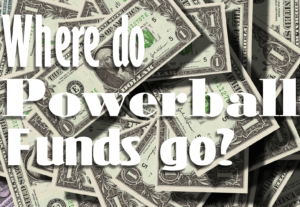Where Do the US Powerball Funds Go?
Last Updated: May 6, 2021
 Lotteries rake in huge sums of money on a weekly basis, but not every cent of the funds raised go to the lucky winners. Lotteries, after all, are primarily there to help fund various government or social projects. The US Powerball is no exception—but where does the funds go exactly? Join me as I take a closer look!
[h2 display=”The Big Picture” menu=”The Big Picture”]
Before we dive right in to the nitty gritty, it’s important to get a good look at the big picture first. According to the Multi-State Lottery Association, the US Powerball’s total tales from April 1992 to January 9, 2016 hovers around the $55.8 billion mark. In that span of time, they have paid a total of $16.5 billion to jackpot winners, and a total of $11.8 billion to tertiary winners—which means that almost half of the funds have gone to winners.
That still leaves a large chunk left. But states don’t get to count it as profit immediately—they still have to pay for various expenses first. These include the salaries for lotto workers, vendor fees, advertising, accounting and the like. Once those are settled, only then can states tally their profits and decide where they want to use the funds on.
[h2 display=”Where Do Powerball Funds Go?” menu=”Where Funds Go”]
Not every lottery uses their funds for the same projects, and the same can be said of states. Pennsylvania, for example, spends a large chunk of its funds on programs aimed at helping the elderly, while Wisconsin uses almost all its lottery funds to lower state property tax.
That said, education is the most common beneficiary of lottery funds—and this is also where a sizeable portion of the US Powerball funds go. According to La Fleur’s, a lottery publication, data from fiscal year 2014 breaks it down like this:
Lotteries rake in huge sums of money on a weekly basis, but not every cent of the funds raised go to the lucky winners. Lotteries, after all, are primarily there to help fund various government or social projects. The US Powerball is no exception—but where does the funds go exactly? Join me as I take a closer look!
[h2 display=”The Big Picture” menu=”The Big Picture”]
Before we dive right in to the nitty gritty, it’s important to get a good look at the big picture first. According to the Multi-State Lottery Association, the US Powerball’s total tales from April 1992 to January 9, 2016 hovers around the $55.8 billion mark. In that span of time, they have paid a total of $16.5 billion to jackpot winners, and a total of $11.8 billion to tertiary winners—which means that almost half of the funds have gone to winners.
That still leaves a large chunk left. But states don’t get to count it as profit immediately—they still have to pay for various expenses first. These include the salaries for lotto workers, vendor fees, advertising, accounting and the like. Once those are settled, only then can states tally their profits and decide where they want to use the funds on.
[h2 display=”Where Do Powerball Funds Go?” menu=”Where Funds Go”]
Not every lottery uses their funds for the same projects, and the same can be said of states. Pennsylvania, for example, spends a large chunk of its funds on programs aimed at helping the elderly, while Wisconsin uses almost all its lottery funds to lower state property tax.
That said, education is the most common beneficiary of lottery funds—and this is also where a sizeable portion of the US Powerball funds go. According to La Fleur’s, a lottery publication, data from fiscal year 2014 breaks it down like this:
- Roughly 50% of the funds go to winners.
- Around 29% of every $2 ticket sold goes to education.
- 5% goes to administration.
- 5% goes to the state’s general funds.
- 10% goes to other other expenses/projects.
- 65% goes to winners.
- 27% goes to education.
- 5.5% in commissions go to retailers.
- 1.4% goes to vendors.
- 1.3% goes to operating expenses.
- 60% goes to winners.
- 30% goes to education.
- 6% goes to retailers.
- 1.6% goes to gambling contractor fees.
- 1.6% goes to operating expenses.
